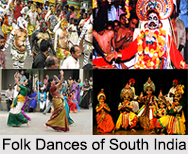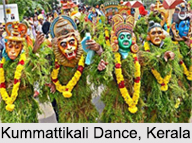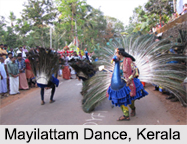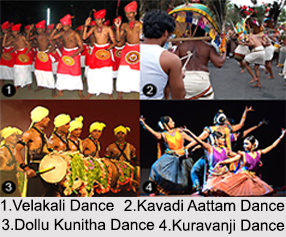 India is a land of varied culture and traditions. Our country has made great contributions in different dance forms, starting from classical, tribal to folk. Folk dances are performed for every possible occasion - to celebrate the arrival of seasons, child birth, weddings and festivals, which are a plenty. The South Indian folk dances are no different and they bring out the lifestyle and traditions of the people. Discussed elaborately below are the myriad South Indian folk dances from the states of Kerala, Karnataka, Andhra Pradesh, Telangana and Tamil Nadu and the union territory of Puducherry.
India is a land of varied culture and traditions. Our country has made great contributions in different dance forms, starting from classical, tribal to folk. Folk dances are performed for every possible occasion - to celebrate the arrival of seasons, child birth, weddings and festivals, which are a plenty. The South Indian folk dances are no different and they bring out the lifestyle and traditions of the people. Discussed elaborately below are the myriad South Indian folk dances from the states of Kerala, Karnataka, Andhra Pradesh, Telangana and Tamil Nadu and the union territory of Puducherry.
Kummattikali: Performed during the festival of Onam, this South Indian folk dance called Kummattikali is a colourful mask dance. The dancers wear painted wooden masks and adorn their bodies with leaves and grass dress. The dance is performed with the musical tunes from the onavillu strings.
Arjuna Nritham: Another South Indian folk dance of Kerala which is also popularly known as Mayilpeeli Thookkam since the lower part o the costume is made with peacock feathers. Arjuna Nritham is a ritual art performed by men with a traditional lamp Nilavilakku for lighting.
Poorakkali: Primarily celebrated during the 9 days of Pooram festival in Bhagavathy temples across North Malabar of South India. The Poorakkali dancers are expected to know all the techniques and feats of Kalaripayattu, a system of physical exercise formerly famous in Kerala.
Thullal: A popular performing art South Indian folk dance, Thullal is a solo dance exposition of Kerala. There are three different types of Thullal and the classification is based upon the metre and rhythm of the songs and the costume, adornments and dance.
 Kurathiyattom: Traditionally executed in the Shiva temples, this South Indian folk dance of Kurathiyattom narrates the story of Kuravan and Kurathi, which are Lord Shiva and Goddess Parvati in disguise.
Kurathiyattom: Traditionally executed in the Shiva temples, this South Indian folk dance of Kurathiyattom narrates the story of Kuravan and Kurathi, which are Lord Shiva and Goddess Parvati in disguise.
Yakshagna: A form of folk theatre from Karnataka, Yakshagna is an exemplary ancient art relating with many of the traditions and conventions of the Sanskrit theatre or drama, particularly those of the Purvaranga and the existence of a character, vidushaka. The first Yakshagana play was in Telugu and was written in the 16th century by Peda Kempa Gaudan and was called as Ganga Gauri Vilasam. The renaissance period dawned upon, followed by the 17th century, which was the time when the Yakshagana form developed in Karnataka, Andhra Pradesh and Tamil Nadu.
Dollu Kunitha: A major form of South Indian folk dance of Karnataka, Dollu Kunitha is performed with the beating of drums and is accompanied by singing. It is one of the ritualistic dances that are popular with the kurubas of Beereshvara Sampradaya.
Bhuta Kola: Also known as Bhootha Aradhane, this South Indian folk dance called Bhuta Kola is an ancient ritual dance performed by the Tulu</b> community to worship the spirits. It is similar to the folk dance form of Theyyam. The main idea behind this folk dance is to appease the devil and protect the environment. A procession with idols of bhoothas is taken out.
 Nagamandala: The Nagamandala Dance is a ritual dance presented in south Karnataka to tranquilize the serpent spirit and is an extravagant night-long affair. The serpent of Karnataka`s Nagamandala celebration is generally believed to be the symbol of fruitfulness and a personification of life-force. The celebration employs music, dance and ritual chanting in Sanskrit and Kannada and is controlled by the head-priest.
Nagamandala: The Nagamandala Dance is a ritual dance presented in south Karnataka to tranquilize the serpent spirit and is an extravagant night-long affair. The serpent of Karnataka`s Nagamandala celebration is generally believed to be the symbol of fruitfulness and a personification of life-force. The celebration employs music, dance and ritual chanting in Sanskrit and Kannada and is controlled by the head-priest.
Bhamakalapam and Gollakalapam: Known to be the most important and traditional folk dance of Andhra Pradesh, Bhamakalapam and Gollakalapam was written by Siddhendra Yogi in the 16th century, to retain the sanctity of dance from the devadasis. He trained a whole clan of Brahmin boys and initiated them into this dance form. Bhamakalapam contains elaborate expressions and complex gesture adhered in by Kuchipudi dance. But in Gollakalapam, a philosophical plot forms the base of this drama, since it is a philosophical play which explains the philosophy of God"s persisting appearance on this earth, whenever, there have been threats to Dharma.
Burra Katha: An ancient dance drama which is an oral storytelling technique in the Katha tradition, performed in villages of Andhra Pradesh and Telangana. Burra Katha is a narrative entertainment that consists of prayers, solo drama, dance, songs, poems and jokes. The topic will be either a Hindu mythological story or a contemporary social issue. Burra Katha was a pastime event in villages. This dance art preaches, entertains and provides relaxation to the rural folk.
Kummi: The most popular South Indian folk dance of Tamil Nadu, Kummi is one of the most important and ancient forms of village dance. This dance form is performed by the women folk with no assistance of musical instruments other than the rhythmic clapping of hands. Kummi is mainly performed during the harvest festival of Pongal.
Kolaattam: Performed by women with the help of sticks, this South Indian folk dance is also known as Kolannalu or Kolkolannalu. The folk dance form of Kolaattam is performed during local village festivals and the festival connected with is dance has both a cultural and a religious significance.
 Kuravanji: This South Indian folk dance form is performed all across the state and the presiding deity of the performance is Lord Vighneswara, another name for Lord Ganesha. Kuravanji is popular in the state of Tamil Nadu and is believed to have originated in the 17th century.
Kuravanji: This South Indian folk dance form is performed all across the state and the presiding deity of the performance is Lord Vighneswara, another name for Lord Ganesha. Kuravanji is popular in the state of Tamil Nadu and is believed to have originated in the 17th century.
Mayilattam: An artistic and religious form of South Indian folk dance, Mayilattam is performed in the Hindu temples of Tamil Nadu. The dance form is practiced in admiration and respect to Lord Subrahmanya. In this type of dance, mostly professionals are seen performing as it demands strength as well as the capability to balance the attire while dancing. Here, the dancers are dressed as peacocks and have to wear peacock feathers with a beak attached in front. The beak is movable as it is tied with a thread and it can be manipulated from within the dress.
Kudakoothu: In this dance form of Kodakoothu, the dancer has to balance a pot of water on head during the performance. This traditional form of dance is also known as Aatta Karagam. These pots have changed over the years from mud pots to bronze ware or stainless steel in modern times. The pots are ornamented with cone of flower arrangements and topped by a parrot that is made of paper. The parrot swings when the dancer moves, thus making this dance form a kind of performing art.
Kuravai: This South Indian folk dance is related to war-operations where the victorious king is joined by soldiers and together dance in circles. This dance is basically a spontaneous expression of joy over victory. The courageous deeds of the king are praised through music and its composition. In Kuravai dance, the rhythm needs to be brisk; with fast limb movements and tunes that match the tempo.
Other than these there are more South Indian folk dances like the Araiyar Seva, Karagam, Kolkali, Sangha Kali, Tiruvathira, Padayani, Ayyapan Vilakku, Thidambu, Paichamuttu Kali, etc. The folk dances serve as an important part of the life of many Indians, as entertainment options, particularly those who live in the rural areas.




